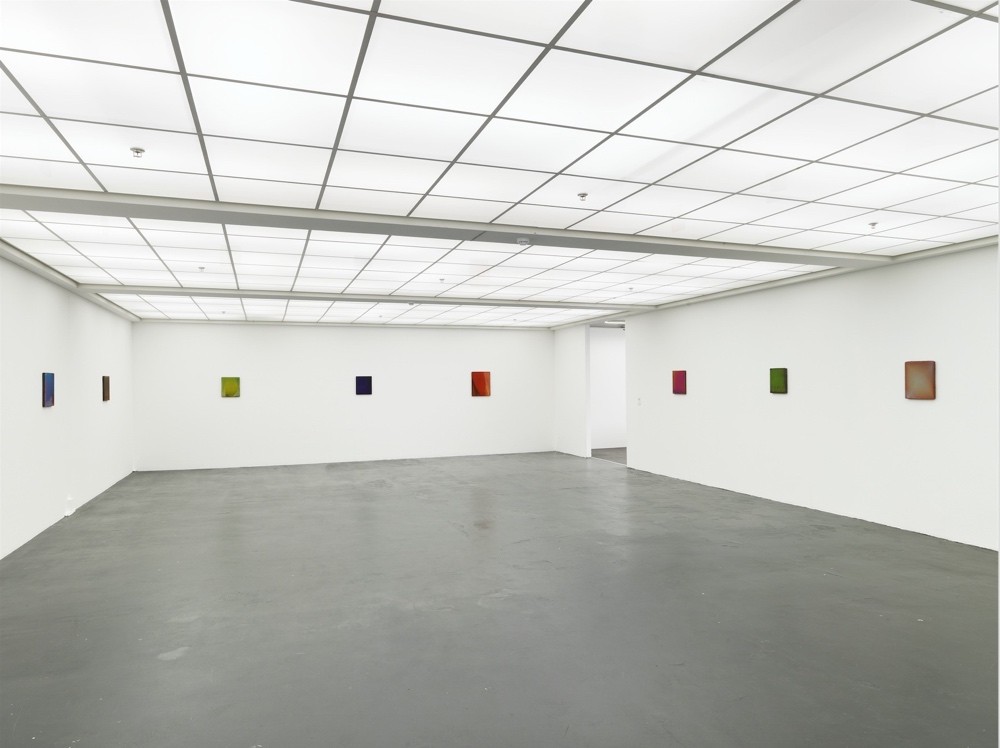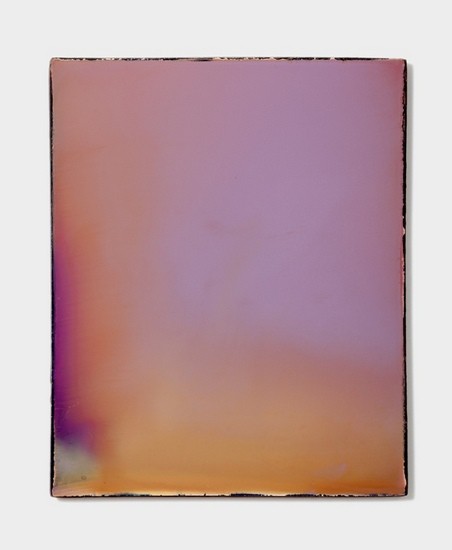Markus Amm
28 Apr - 16 Jul 2017
MARKUS AMM
28 April – 16 July 2017
Markus Amm’s paintings are a challenge. They challenge what we are capable of seeing and how we engage with that. They also, however, challenge what language can express. (...) It is easy to imagine these intensive moments in the studio – a highly concentrated endeavour, the artist almost staking out his work, observing how the thinned oil paint that Amm allows to flow over the boards behaves at every instant. How do the pigments dry and how does the interaction of the colours play out? When must he suddenly intervene to avoid the upper layer drying too fast, thus splitting the taut surface? Correction is not possible in this highly complex process which he chose for himself. To correct would mean sanding the paint applied off the ground and starting the whole process again. Every movement must work. It almost seems as if Amm is pushing the material, and himself, to their limits: how thin can the oil paint be before it loses its materiality and luminosity? How smooth can the grounds be, how smooth must they be? How swiftly do the artist’s hands have to move? And when does he have to intervene? (...)
There are no breaks for Markus Amm. The material determines when the act of painting can end and the artist can leave the studio. This time- and energy-consuming process which can take many days, even weeks, is followed by the stage of understanding, grasping and seeing. Something that can be described as a picture only crystallises on the surface after the paint’s drying phase. The artist first waits in anticipation of what reveals itself bit by bit, as if it were a polaroid picture, through the surface – as do we, when we look at the painting.
It is tempting to describe the transformation the artist achieves, using materials such as gesso, canvas, oil, pigments, thinner and binding agents to enable an astonishing visual experience in painting, as an alchemical act. Though all the methods and actions can be named and comprehended, the result eludes what can clearly be understood. Markus Amm’s paintings open up to, and at the same time resist, any easy approach. While their edges suggest coarseness, their surfaces radiate astonishing delicacy and fragility. This dynamic relationship and the concurrent constructive abrasion, letting neither the smooth nor the raw have the upper hand, are essential features of Amm’s painting. They are approachable, positive and yet elude our grasp. It is also clear that the artist anticipates no form of framing for his paintings. It would obscure that fruitful encounter of edge and surface, of painting and object, and of tangible and transcendent.
But what is it that presents itself before us here, and what do we call it? His painting captures our eye and makes it see images that seem to have an effect within us, images that continually change as we observe. Even if we think we see suggestions of figuration, Markus Amm’s paintings illustrate nothing and yet seem to show everything: the ground, which is mounted unframed, object-like on the wall, the coexistence and intermingling of different colour runs, and a matt surface that reacts sensitively to the light that falls upon it. It is astonishing how the paintings – despite their sometimes diminutive formats – can hold a wall, a whole room even, and occupy it with their distinct presence.
So an exhibition of paintings by Markus Amm is anything but a work presentation trying to ‘sort’ the pieces with the aid of criteria such as chronology or themes. An exhibition with paintings by Markus Amm, paintings which originate in reality, not abstraction or fiction, must include reality itself and the individual qualities of the given exhibition space. The character of the space must be considered, likewise the light that effects it, whether it be from natural or artificial sources as well as its changes as time progresses. Only with the interplay of painting, proximities, space, light, emptiness and the viewer’s presence can a situation come into being in which the works can emit their astonishing effect.
It is precisely this that is fascinating in Markus Amm’s paintings. They are an invitation to an experience, to spend time with them and to become aware of the moment of looking. In return, they enable heightened sensitivity and a finer quality of seeing for anyone who engages with them. Markus Amm’s paintings are, in fact, a challenge – a challenge worth accepting. (IG)
Extract from the publication of Markus Amm, being published in early June 2017 by Karma.
Markus Amm (*1967, DE), lives and works in Geneva. He became internationally known through participation in major group shows on painting like Variations: Conversations In And Around Abstract Painting at the Los Angeles County Museum of Art, Los Angeles CA or Triumph of Painting 4: Germania at the Saatchi Gallery London in 2008.
28 April – 16 July 2017
Markus Amm’s paintings are a challenge. They challenge what we are capable of seeing and how we engage with that. They also, however, challenge what language can express. (...) It is easy to imagine these intensive moments in the studio – a highly concentrated endeavour, the artist almost staking out his work, observing how the thinned oil paint that Amm allows to flow over the boards behaves at every instant. How do the pigments dry and how does the interaction of the colours play out? When must he suddenly intervene to avoid the upper layer drying too fast, thus splitting the taut surface? Correction is not possible in this highly complex process which he chose for himself. To correct would mean sanding the paint applied off the ground and starting the whole process again. Every movement must work. It almost seems as if Amm is pushing the material, and himself, to their limits: how thin can the oil paint be before it loses its materiality and luminosity? How smooth can the grounds be, how smooth must they be? How swiftly do the artist’s hands have to move? And when does he have to intervene? (...)
There are no breaks for Markus Amm. The material determines when the act of painting can end and the artist can leave the studio. This time- and energy-consuming process which can take many days, even weeks, is followed by the stage of understanding, grasping and seeing. Something that can be described as a picture only crystallises on the surface after the paint’s drying phase. The artist first waits in anticipation of what reveals itself bit by bit, as if it were a polaroid picture, through the surface – as do we, when we look at the painting.
It is tempting to describe the transformation the artist achieves, using materials such as gesso, canvas, oil, pigments, thinner and binding agents to enable an astonishing visual experience in painting, as an alchemical act. Though all the methods and actions can be named and comprehended, the result eludes what can clearly be understood. Markus Amm’s paintings open up to, and at the same time resist, any easy approach. While their edges suggest coarseness, their surfaces radiate astonishing delicacy and fragility. This dynamic relationship and the concurrent constructive abrasion, letting neither the smooth nor the raw have the upper hand, are essential features of Amm’s painting. They are approachable, positive and yet elude our grasp. It is also clear that the artist anticipates no form of framing for his paintings. It would obscure that fruitful encounter of edge and surface, of painting and object, and of tangible and transcendent.
But what is it that presents itself before us here, and what do we call it? His painting captures our eye and makes it see images that seem to have an effect within us, images that continually change as we observe. Even if we think we see suggestions of figuration, Markus Amm’s paintings illustrate nothing and yet seem to show everything: the ground, which is mounted unframed, object-like on the wall, the coexistence and intermingling of different colour runs, and a matt surface that reacts sensitively to the light that falls upon it. It is astonishing how the paintings – despite their sometimes diminutive formats – can hold a wall, a whole room even, and occupy it with their distinct presence.
So an exhibition of paintings by Markus Amm is anything but a work presentation trying to ‘sort’ the pieces with the aid of criteria such as chronology or themes. An exhibition with paintings by Markus Amm, paintings which originate in reality, not abstraction or fiction, must include reality itself and the individual qualities of the given exhibition space. The character of the space must be considered, likewise the light that effects it, whether it be from natural or artificial sources as well as its changes as time progresses. Only with the interplay of painting, proximities, space, light, emptiness and the viewer’s presence can a situation come into being in which the works can emit their astonishing effect.
It is precisely this that is fascinating in Markus Amm’s paintings. They are an invitation to an experience, to spend time with them and to become aware of the moment of looking. In return, they enable heightened sensitivity and a finer quality of seeing for anyone who engages with them. Markus Amm’s paintings are, in fact, a challenge – a challenge worth accepting. (IG)
Extract from the publication of Markus Amm, being published in early June 2017 by Karma.
Markus Amm (*1967, DE), lives and works in Geneva. He became internationally known through participation in major group shows on painting like Variations: Conversations In And Around Abstract Painting at the Los Angeles County Museum of Art, Los Angeles CA or Triumph of Painting 4: Germania at the Saatchi Gallery London in 2008.


